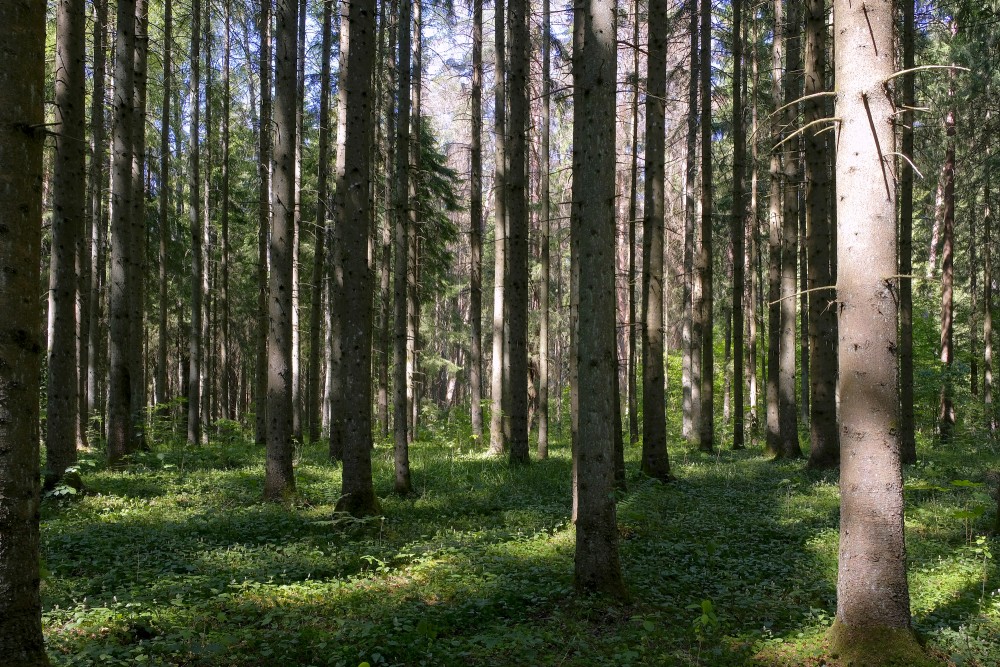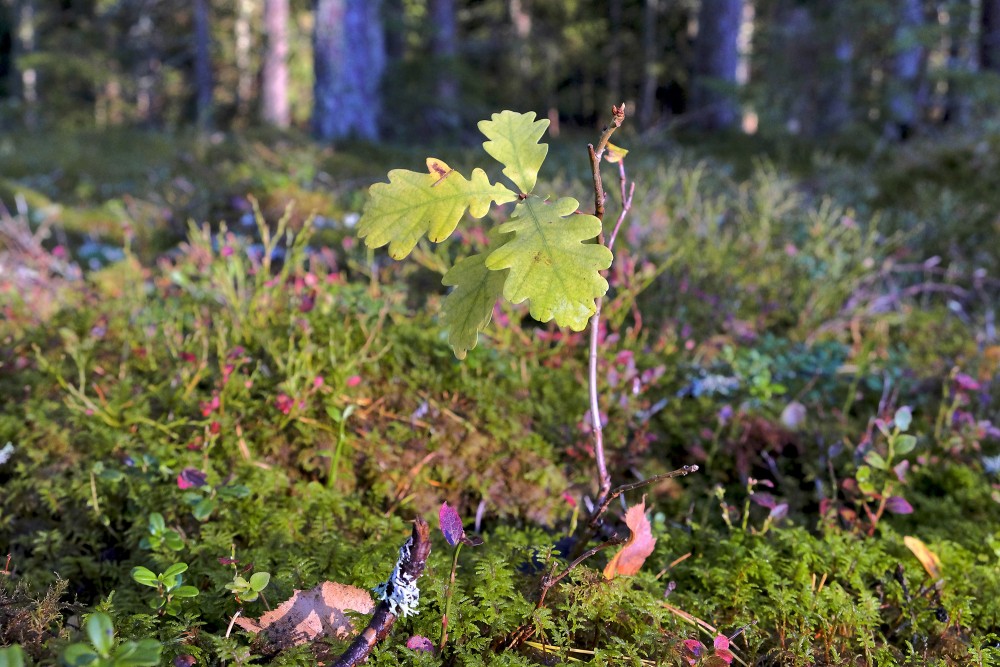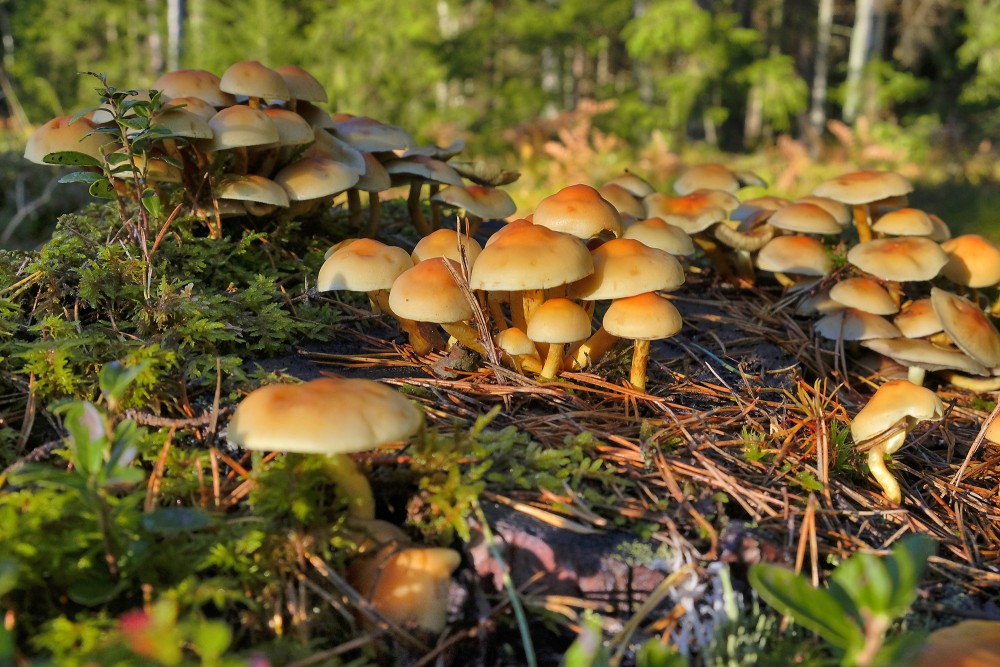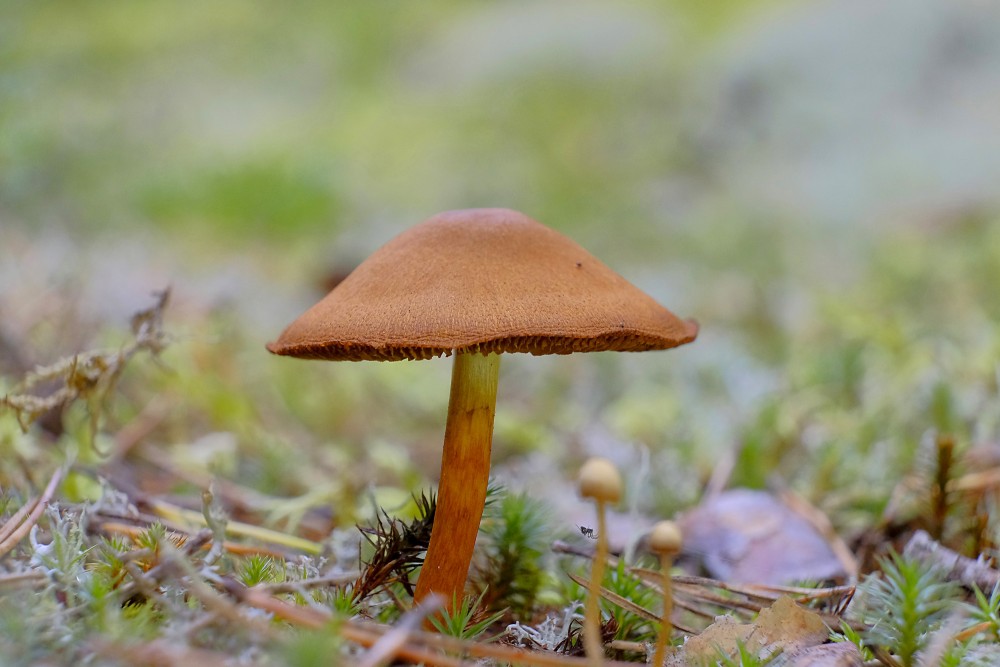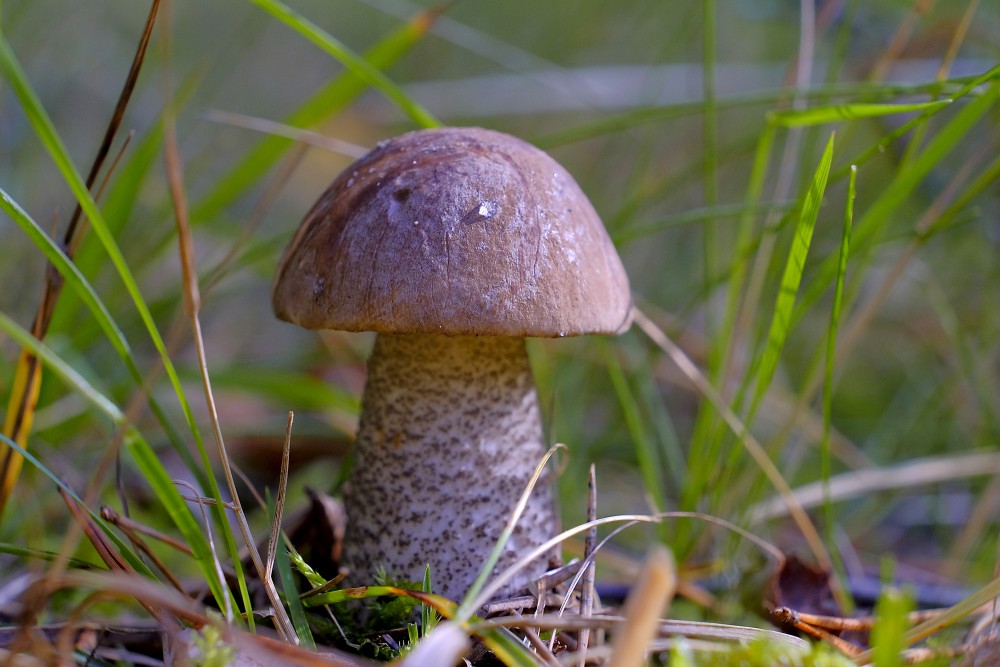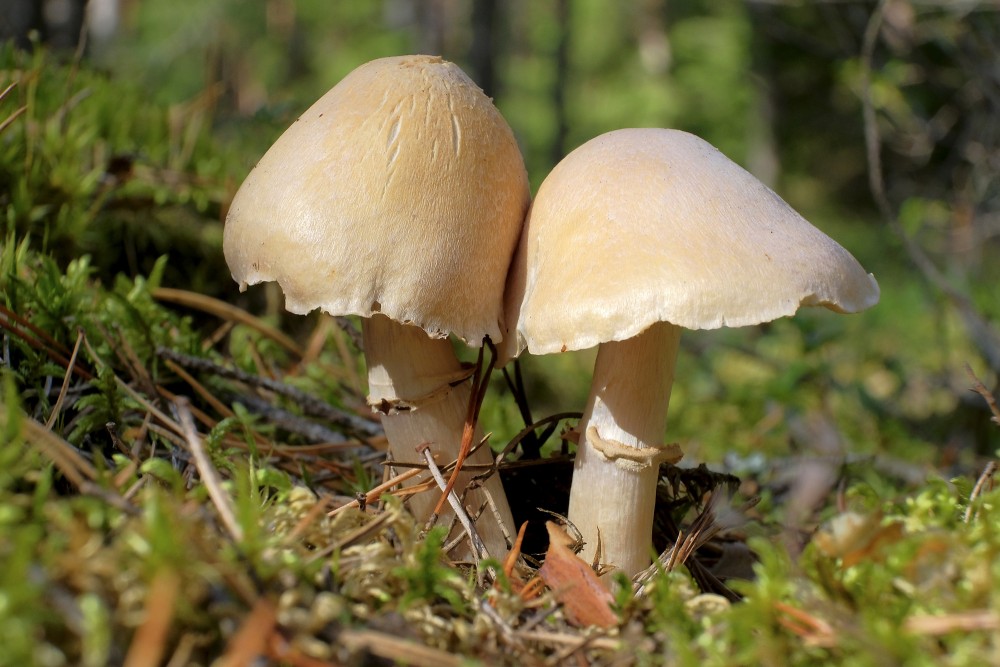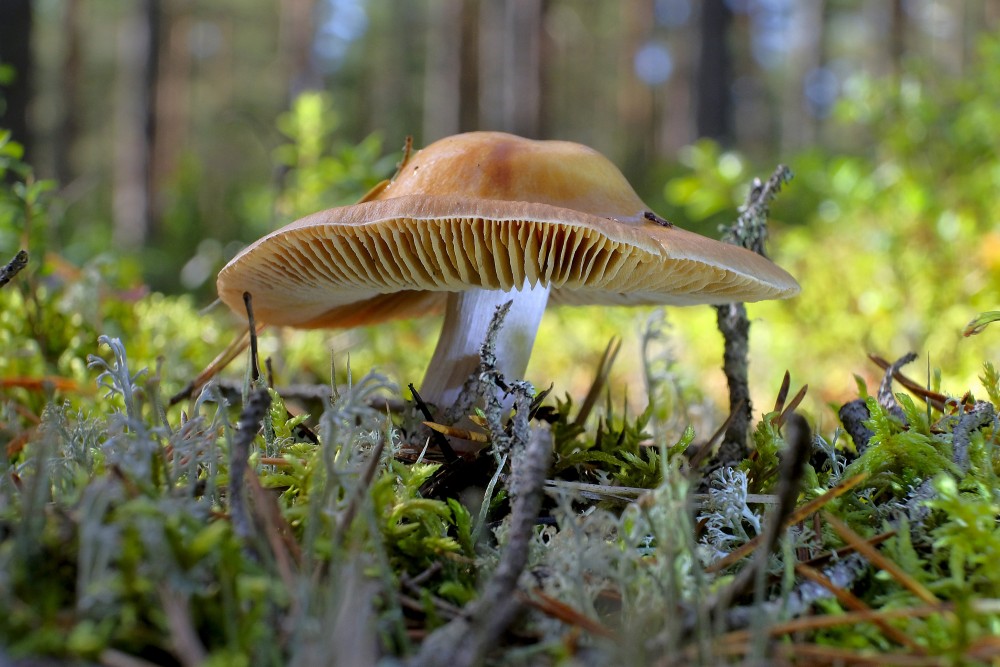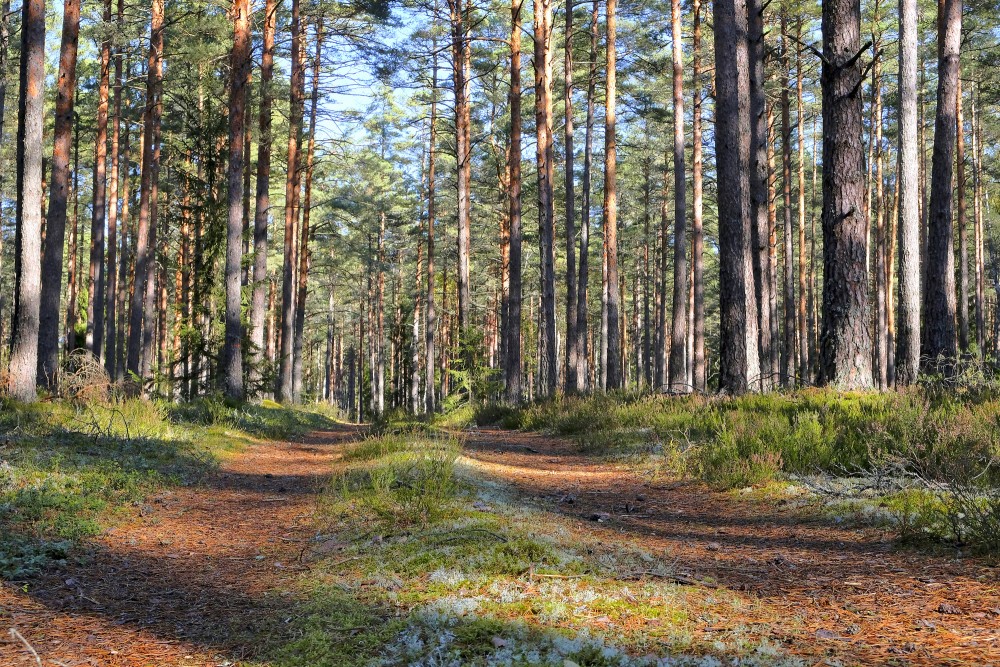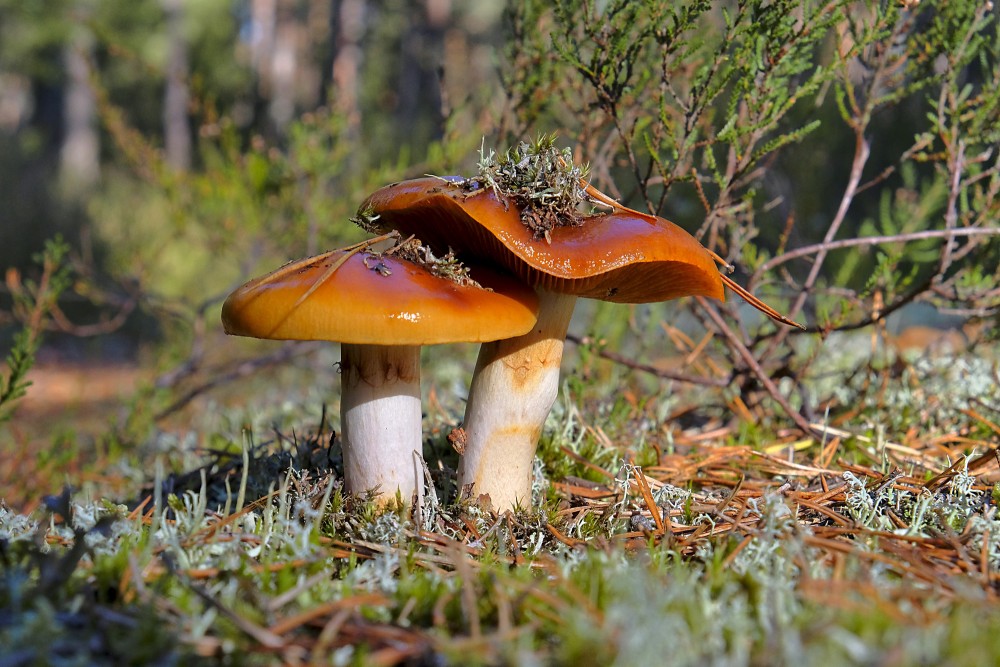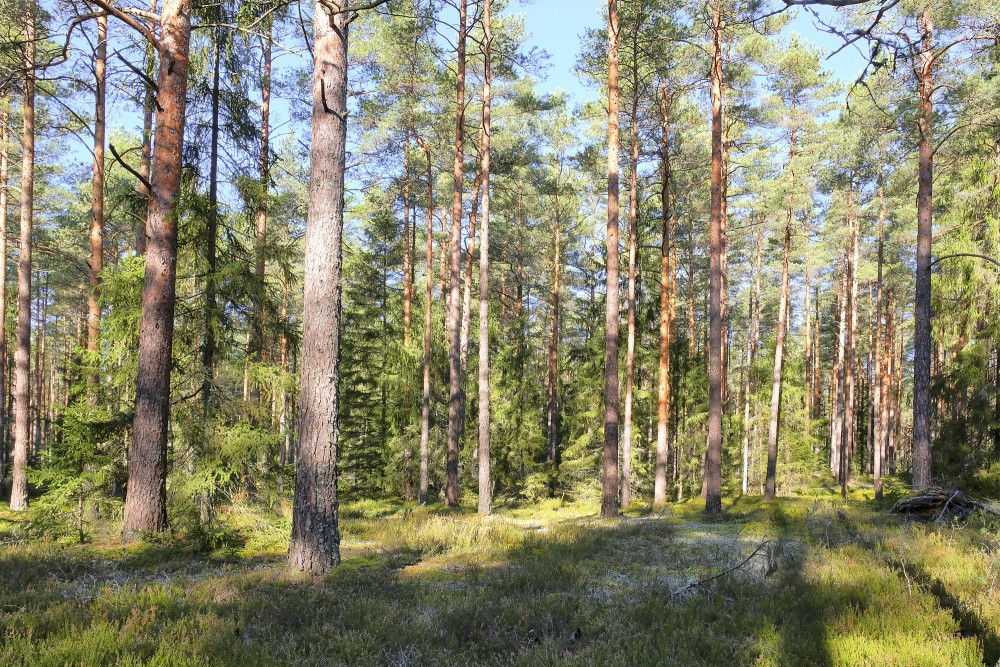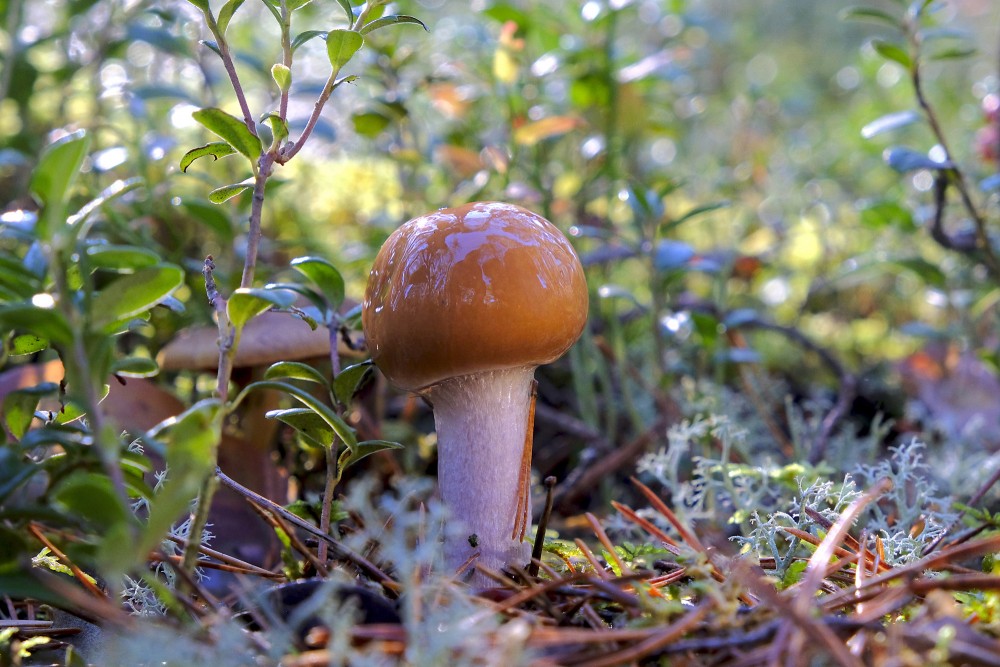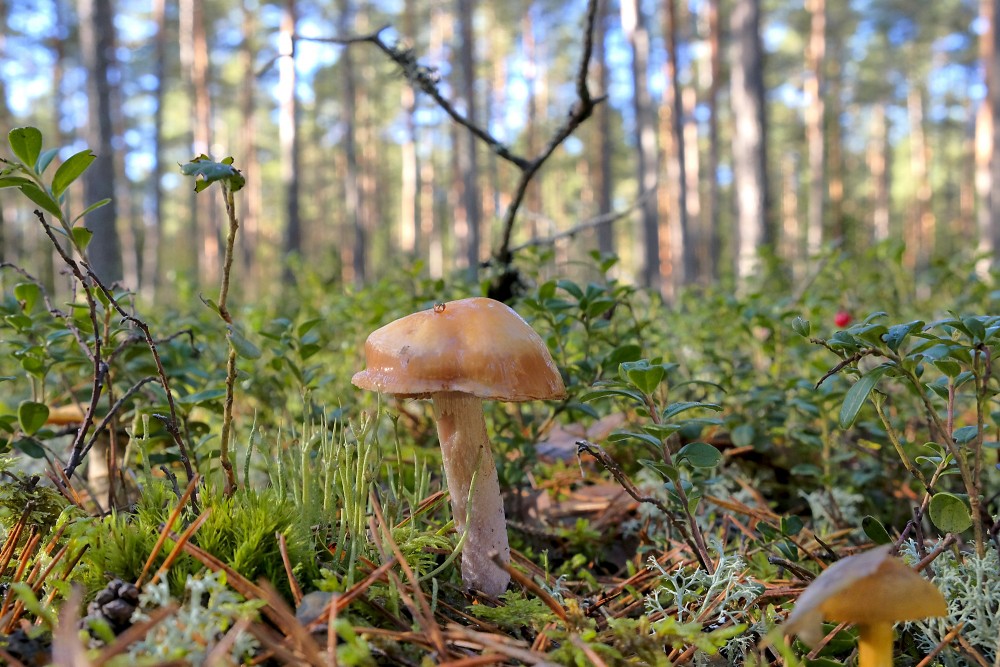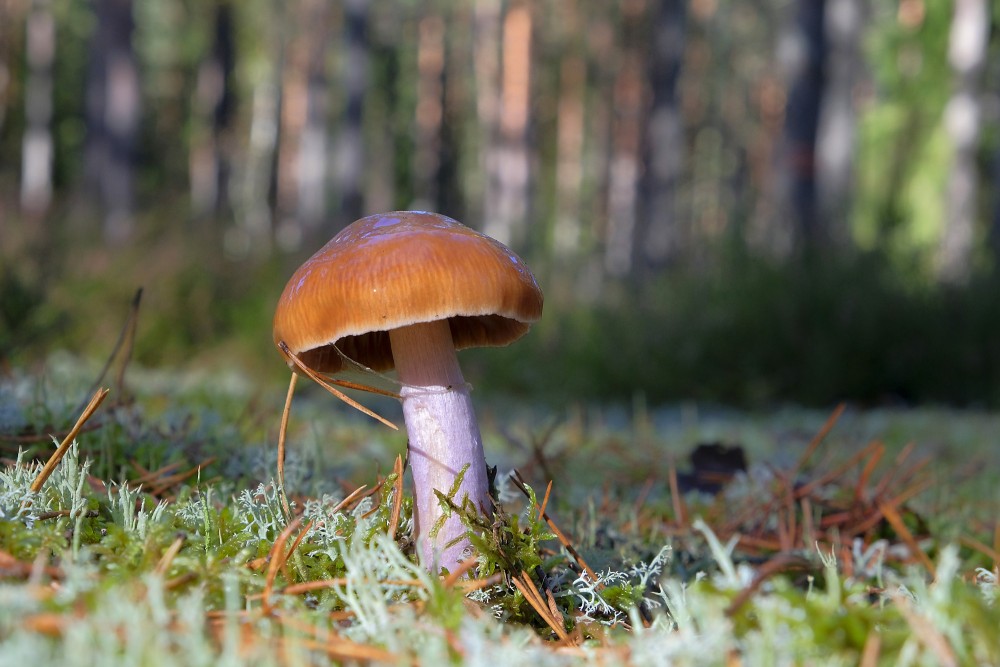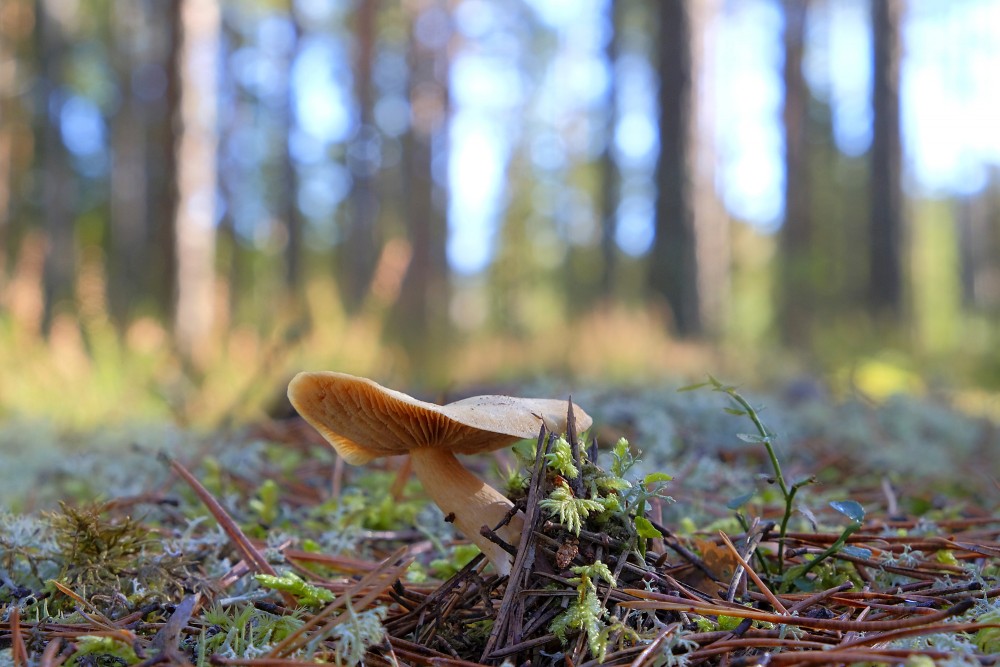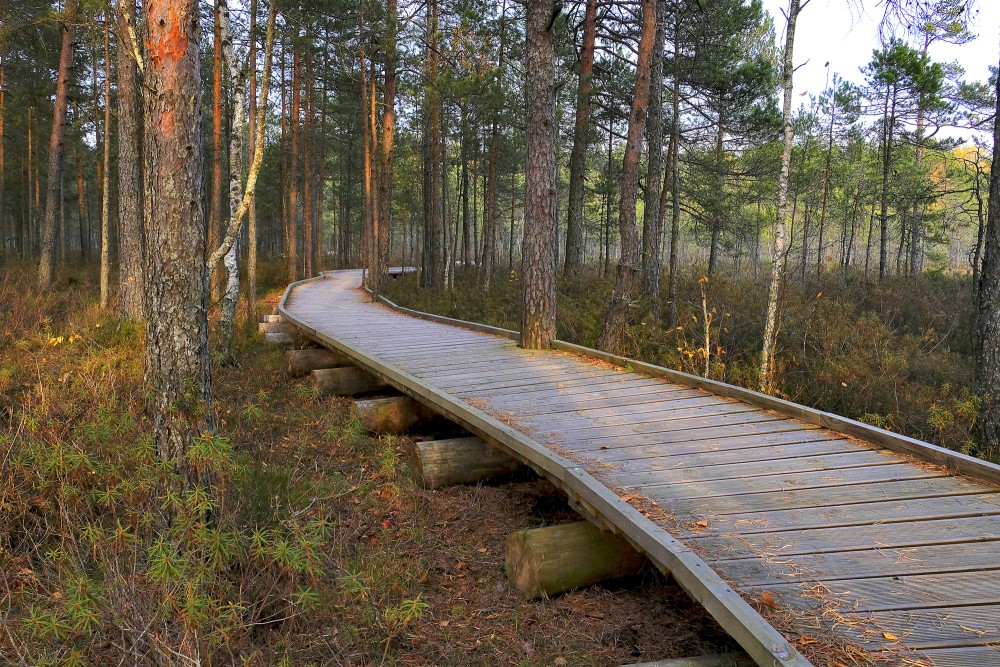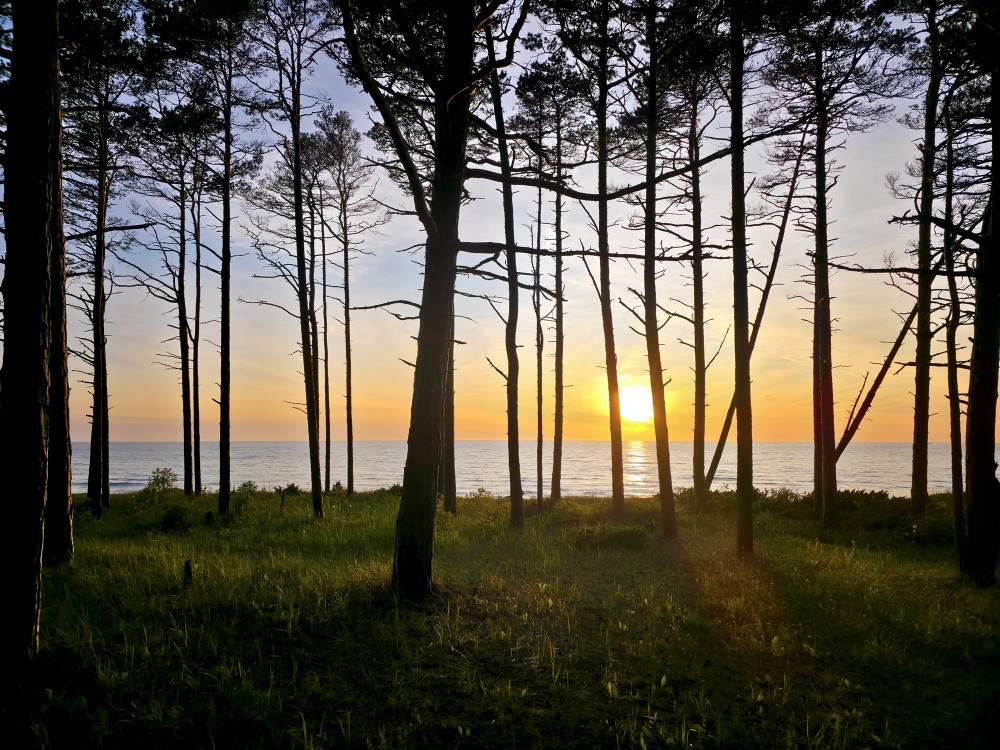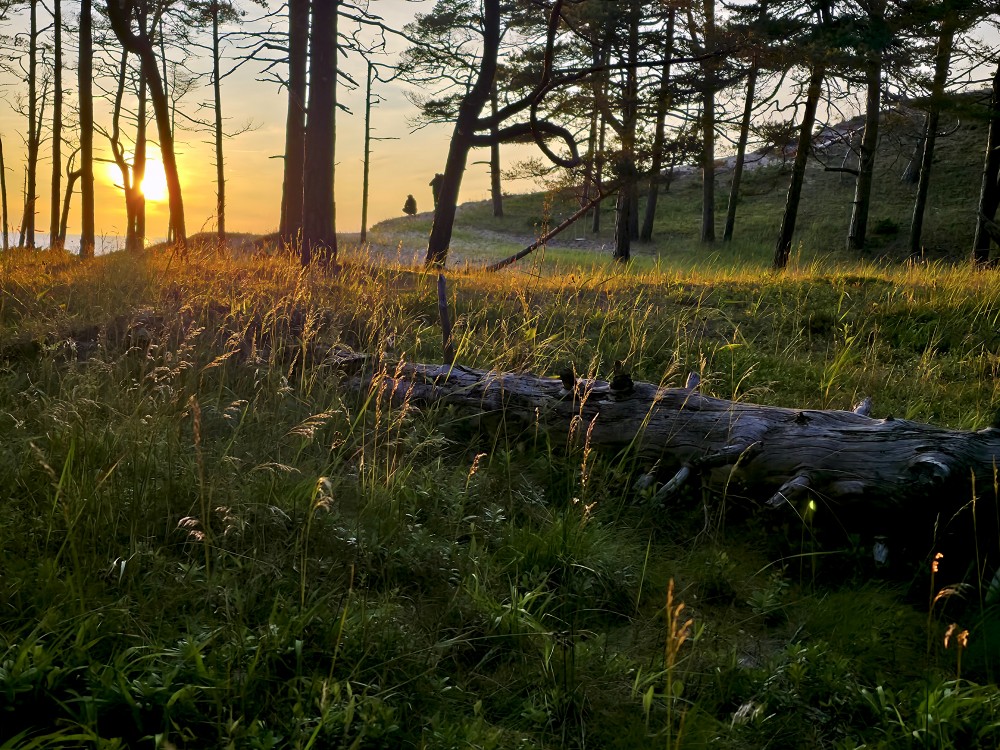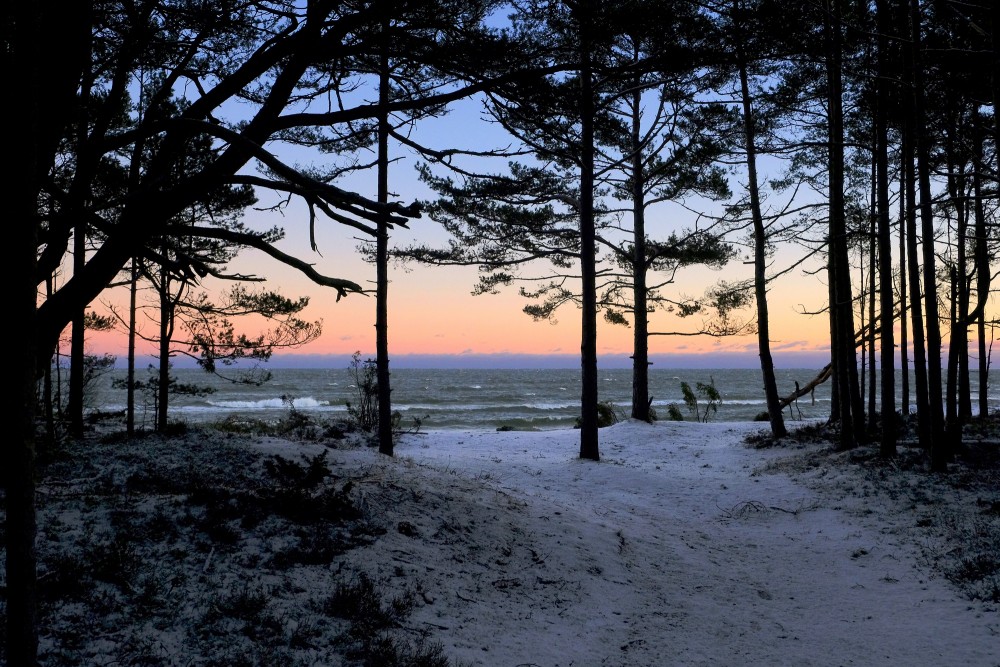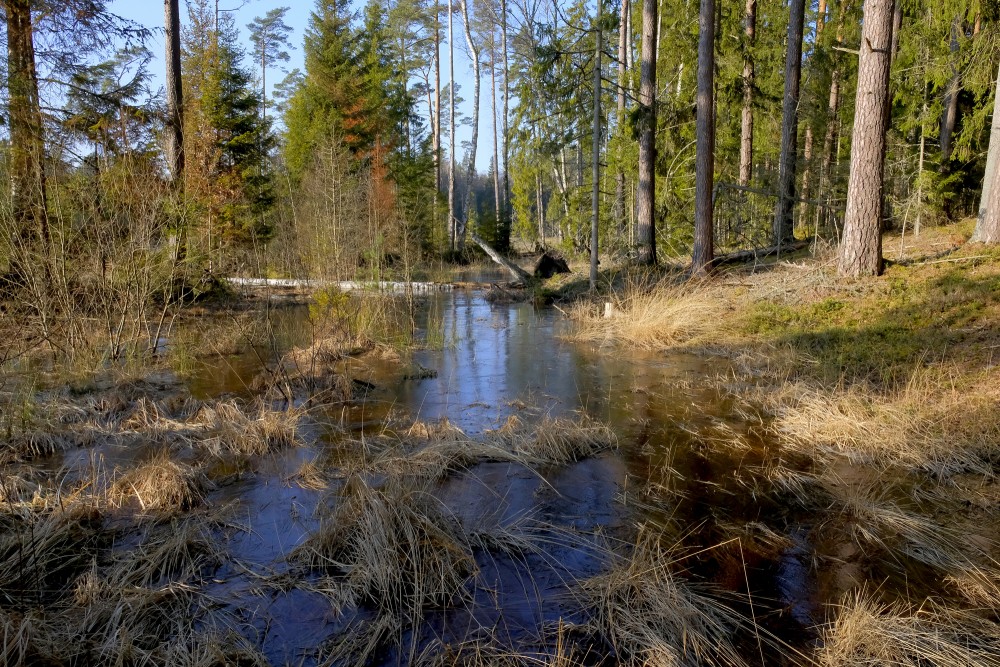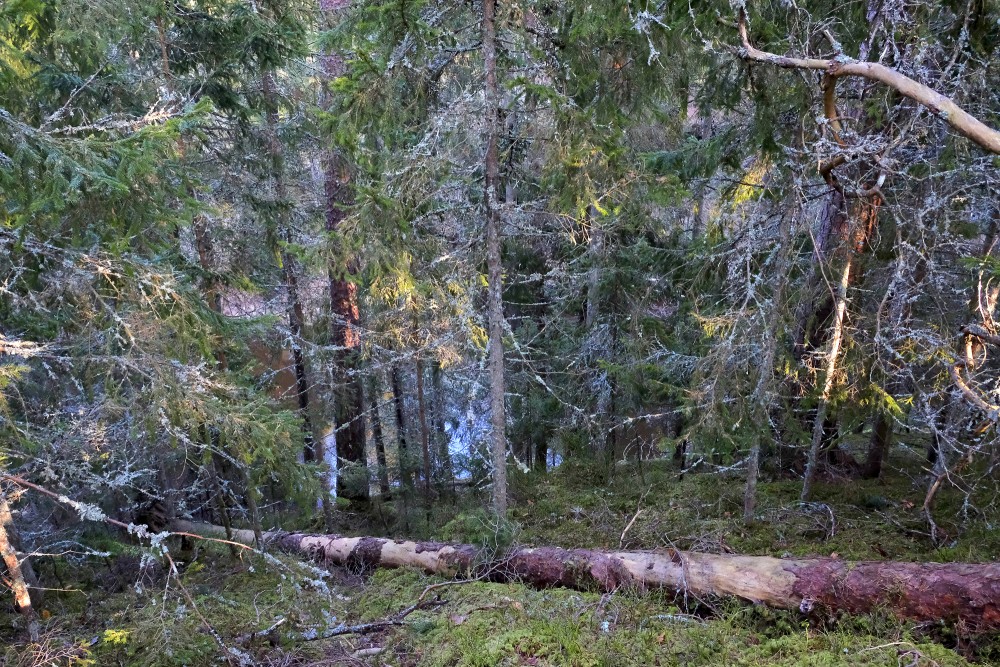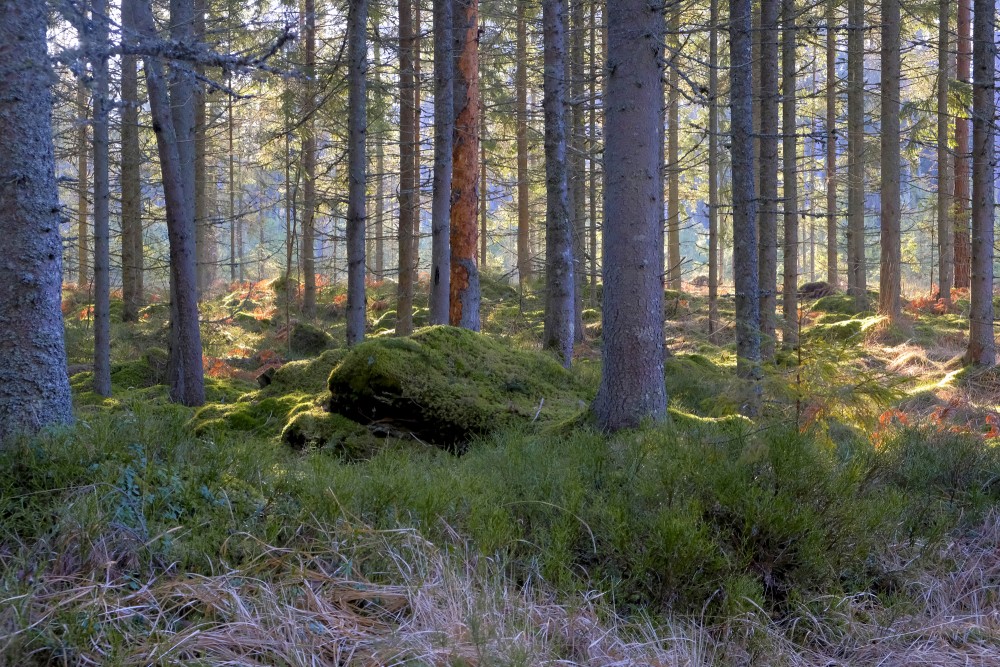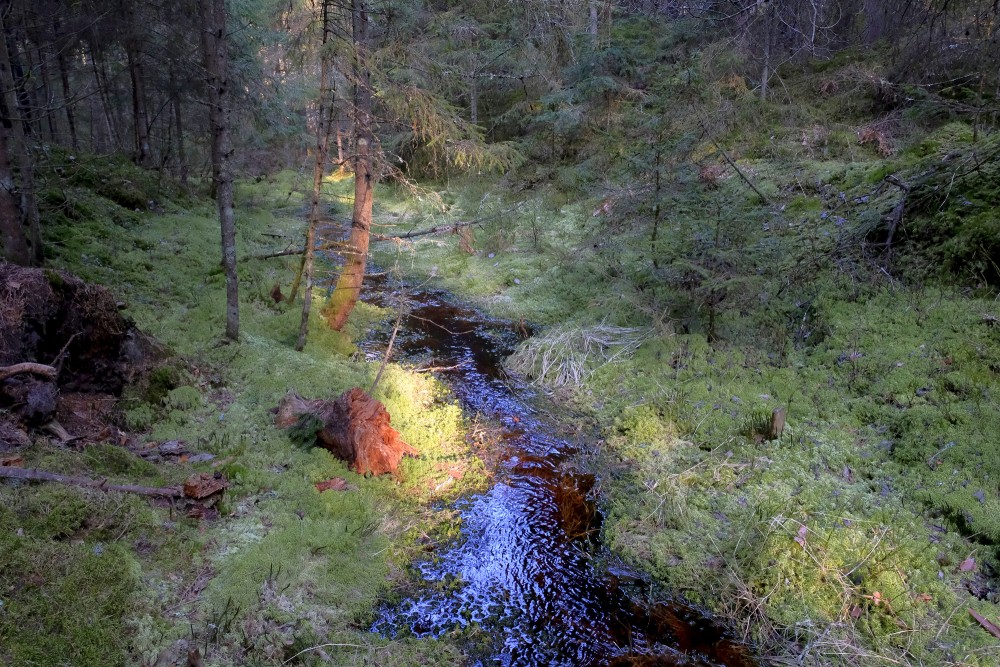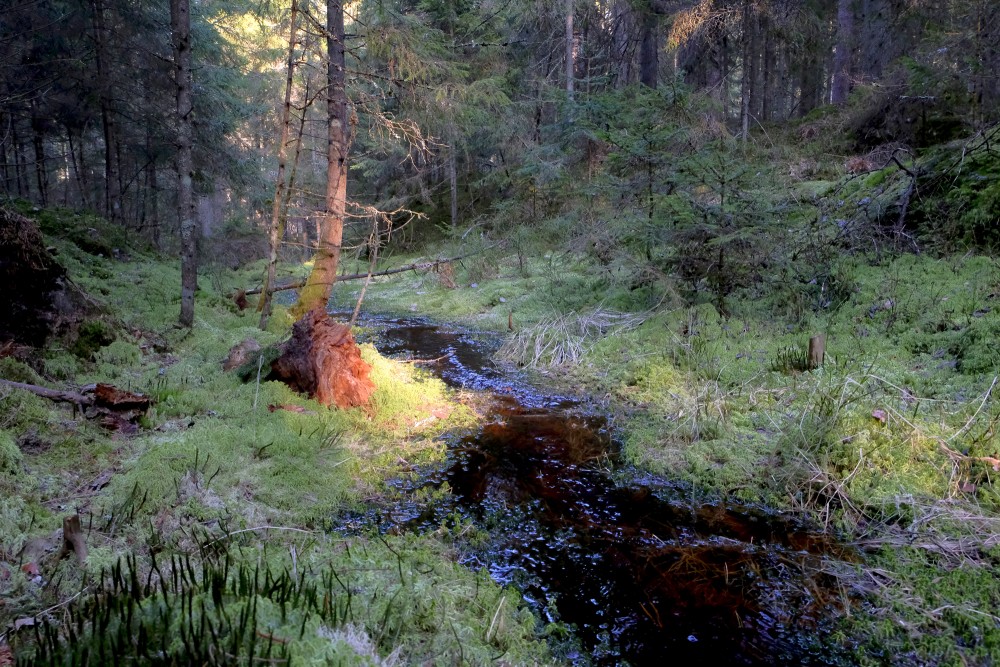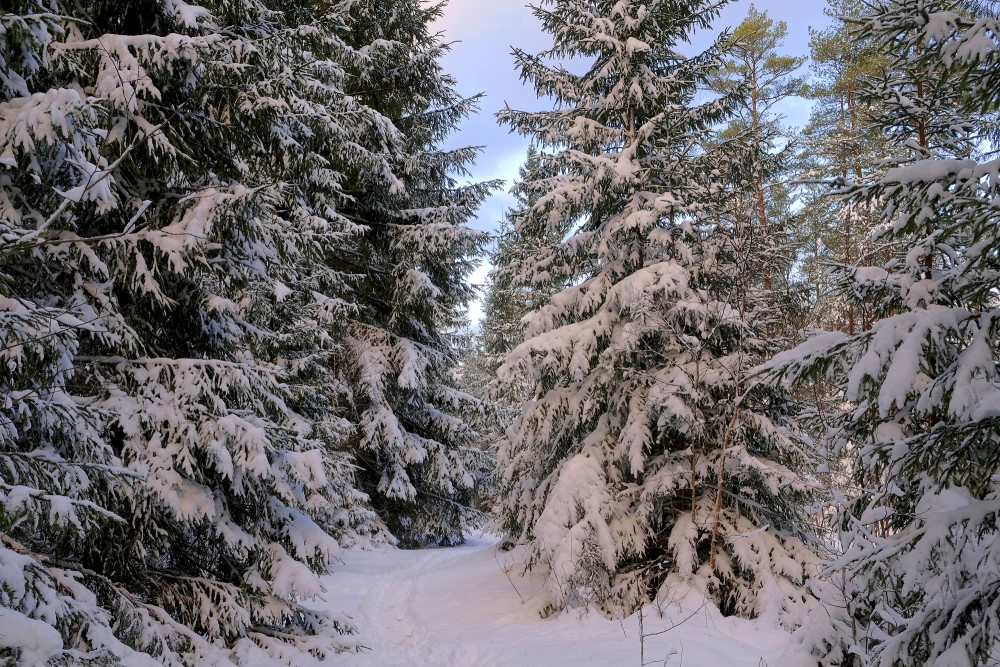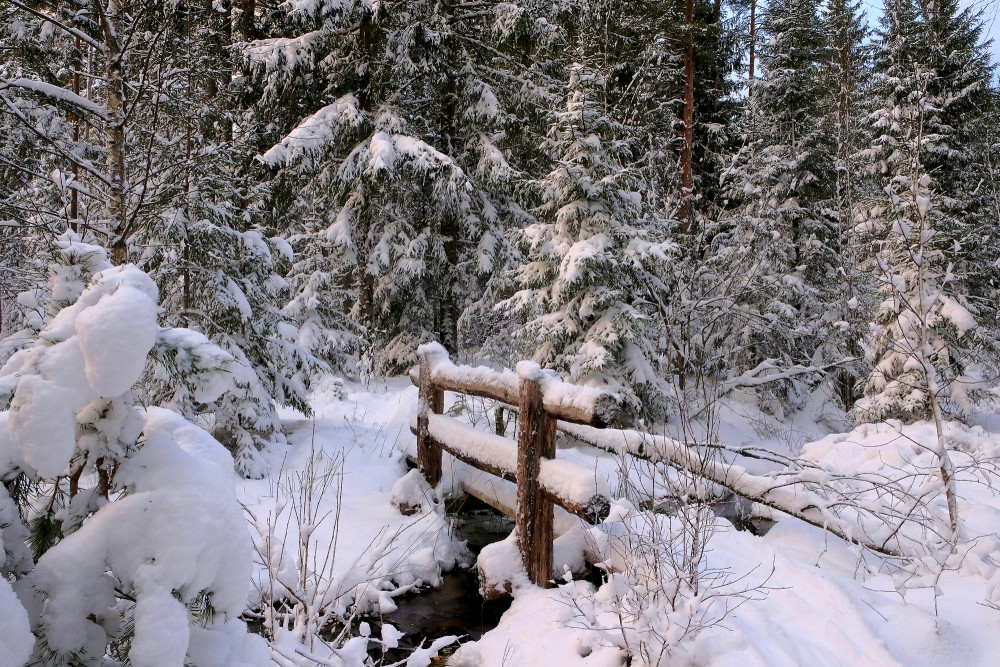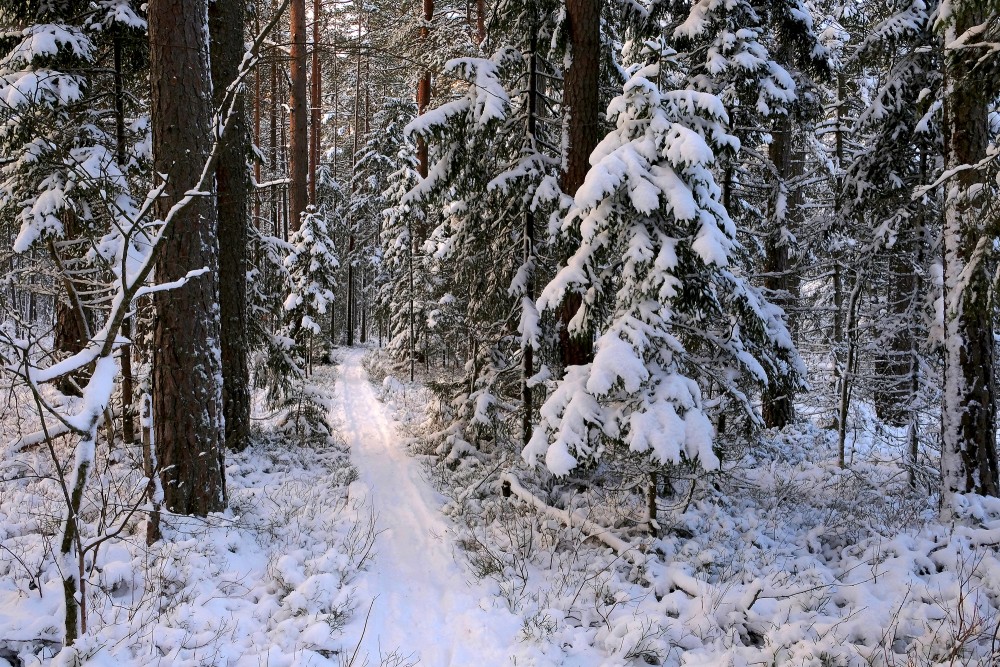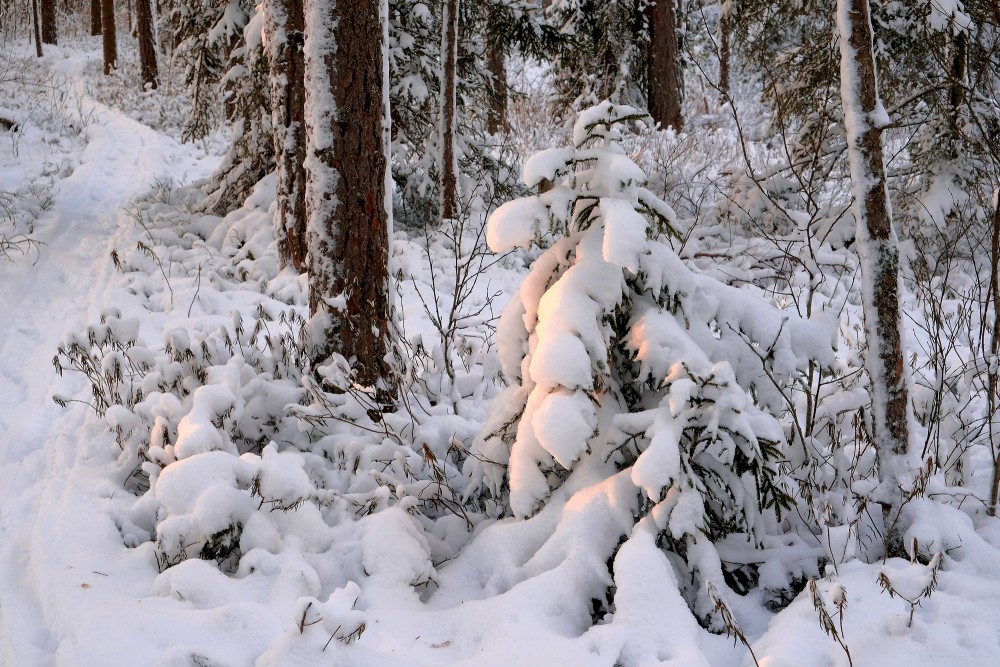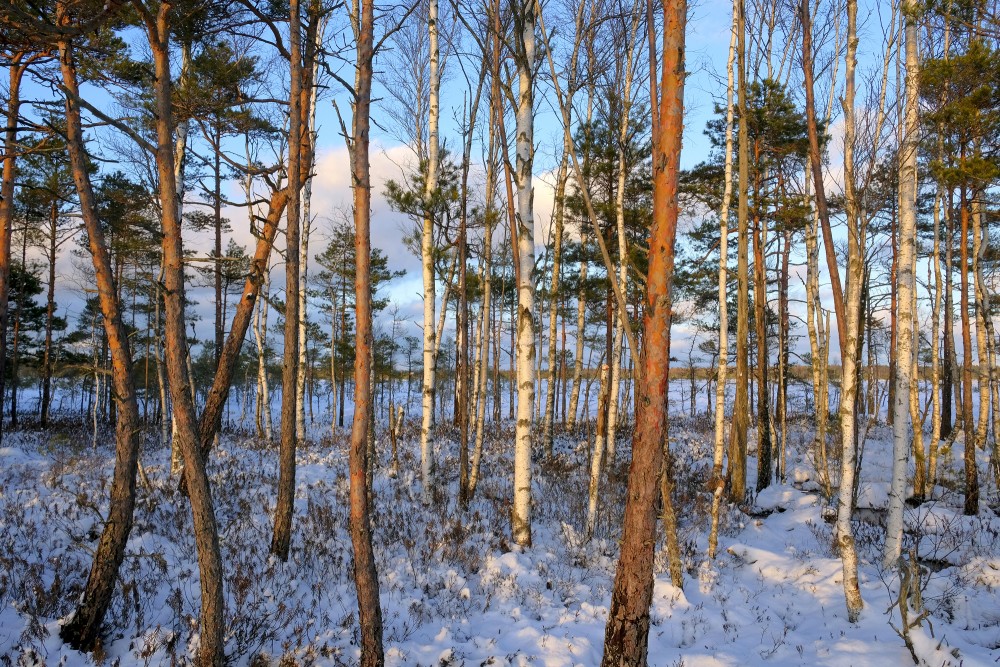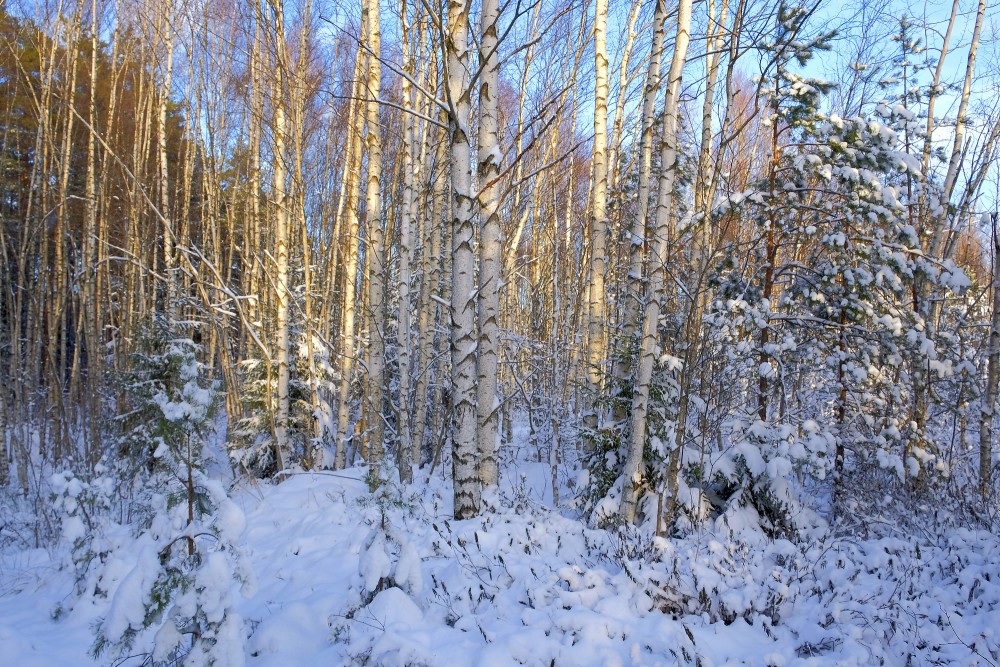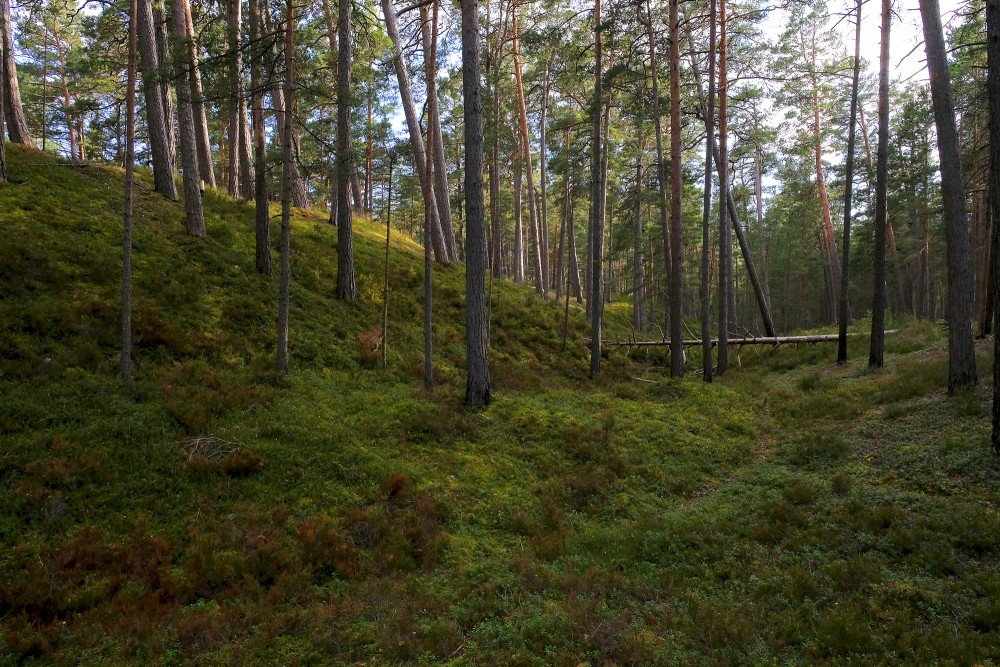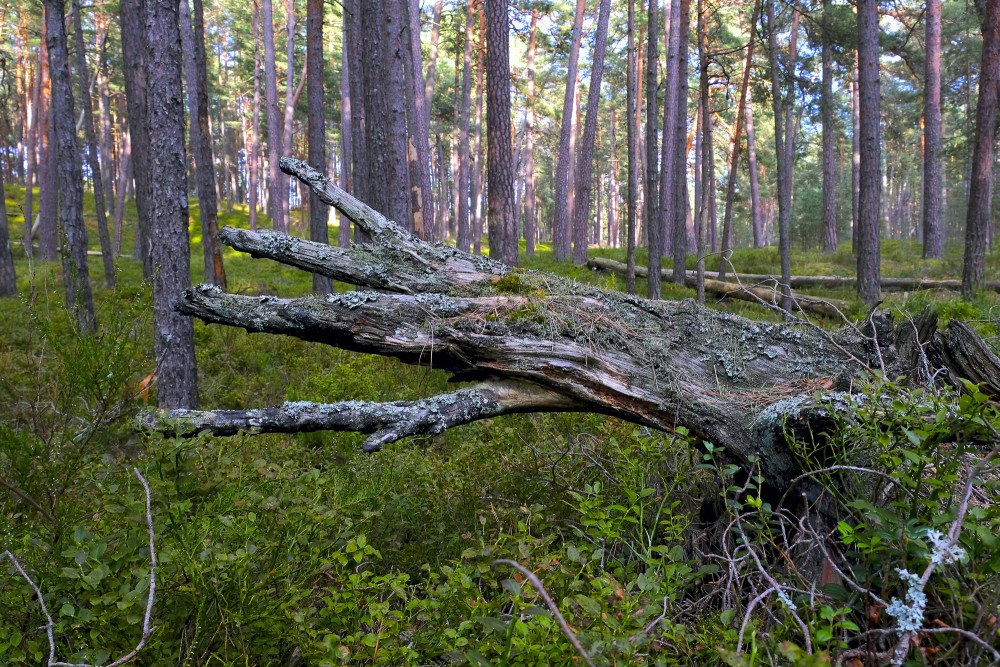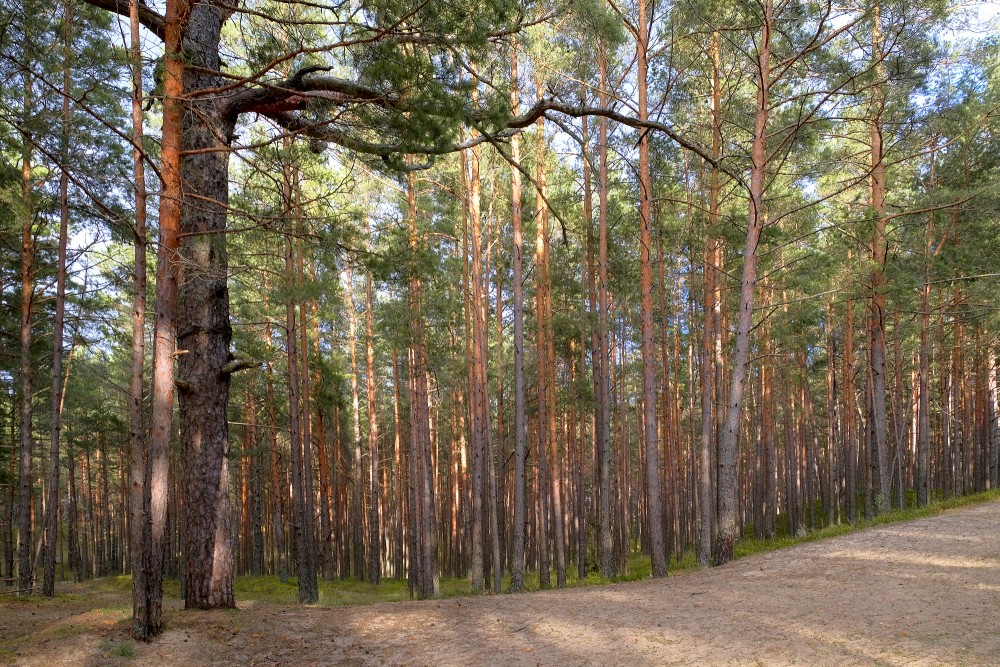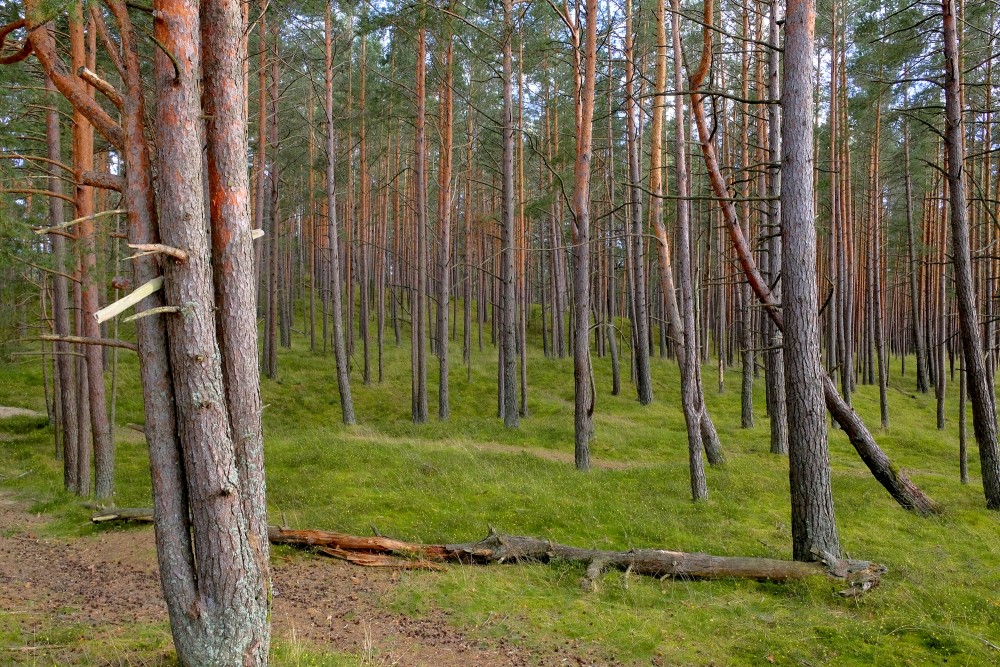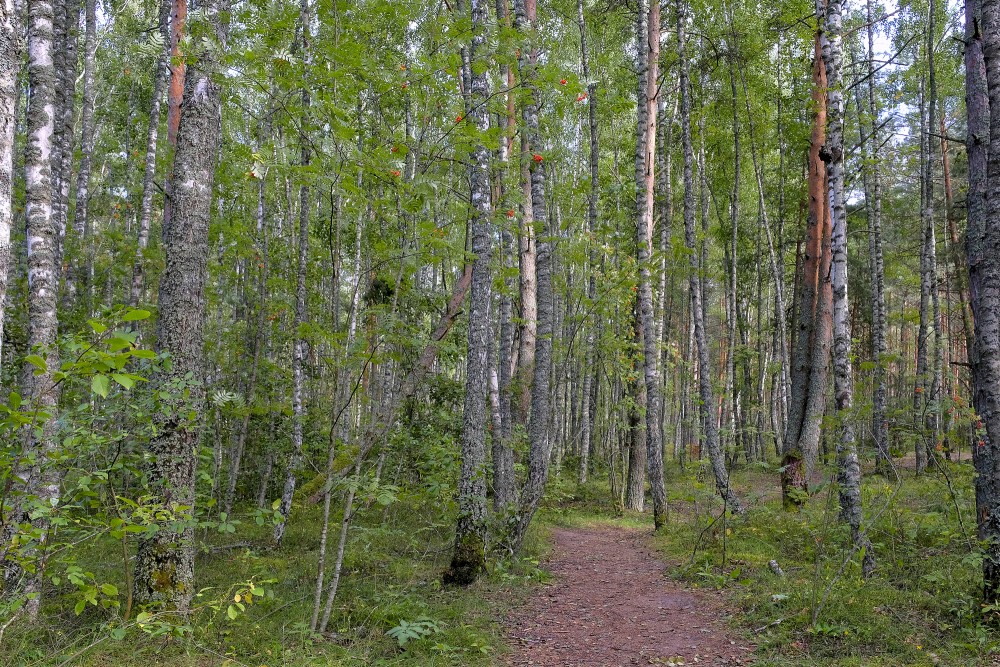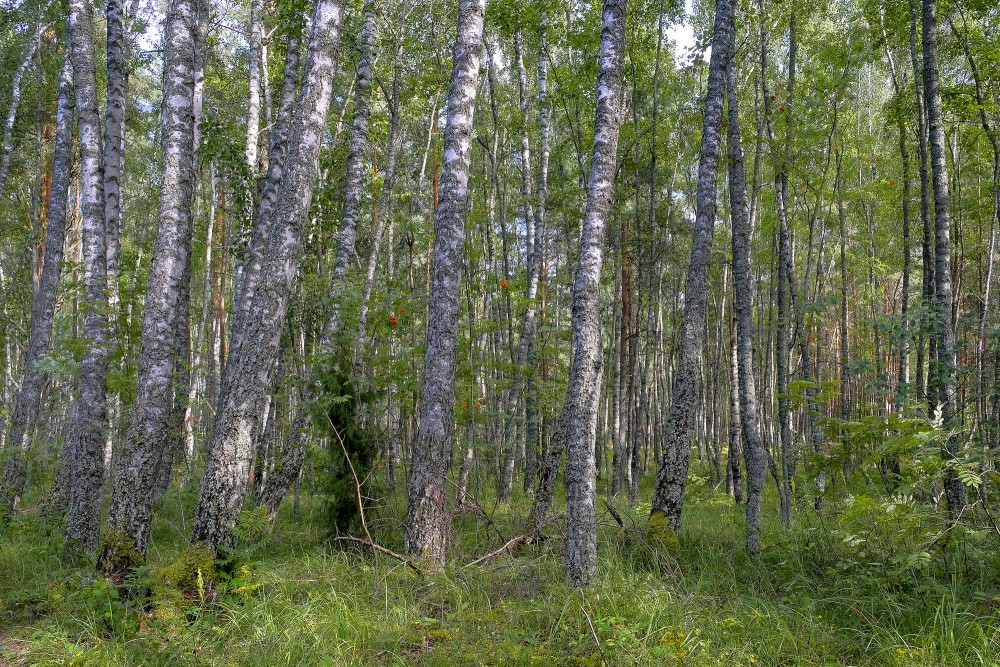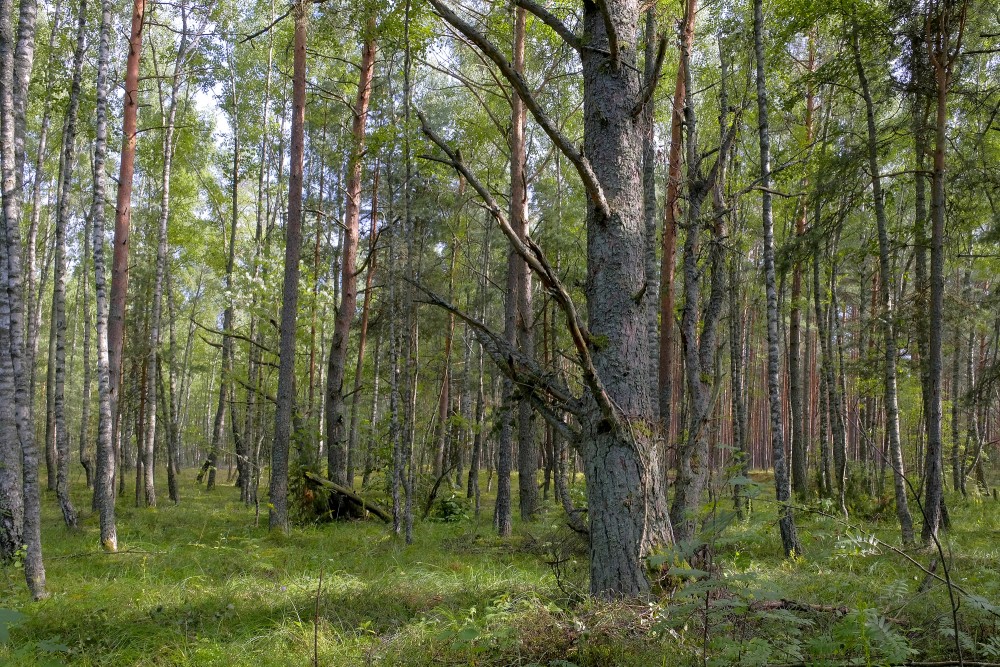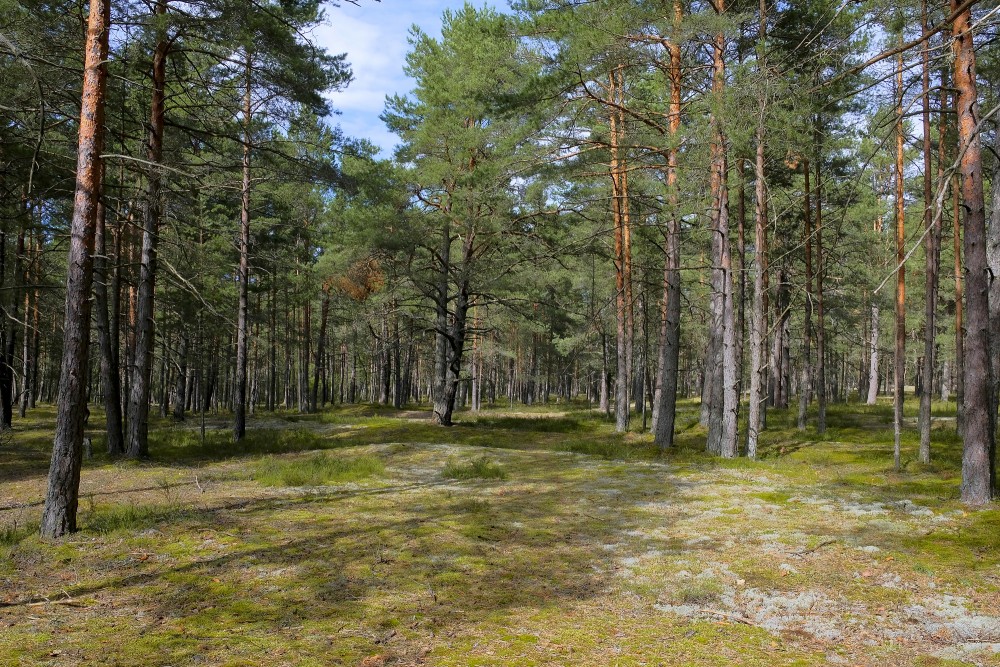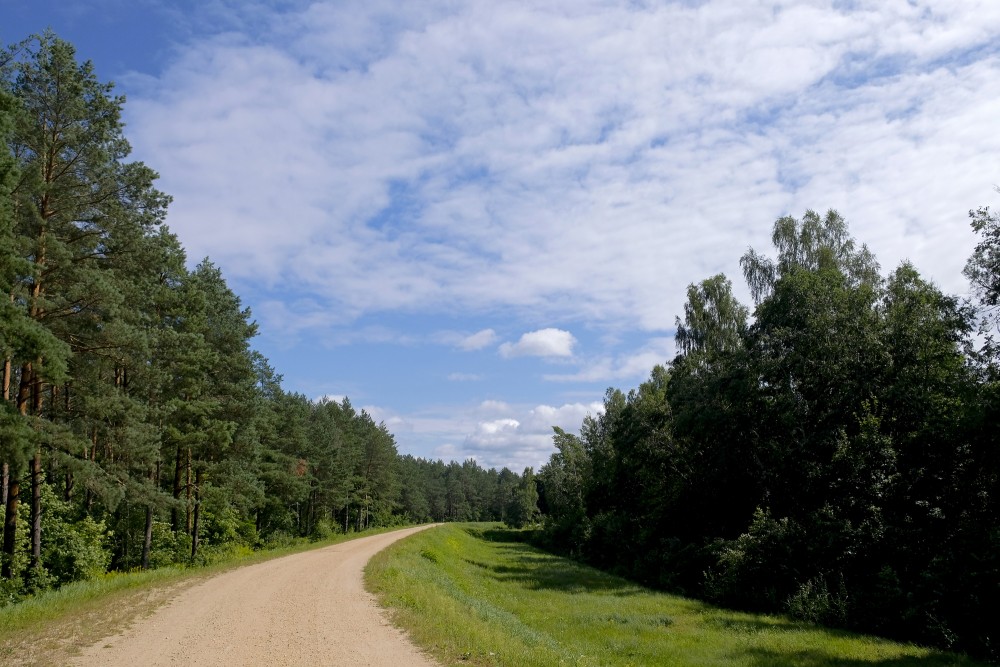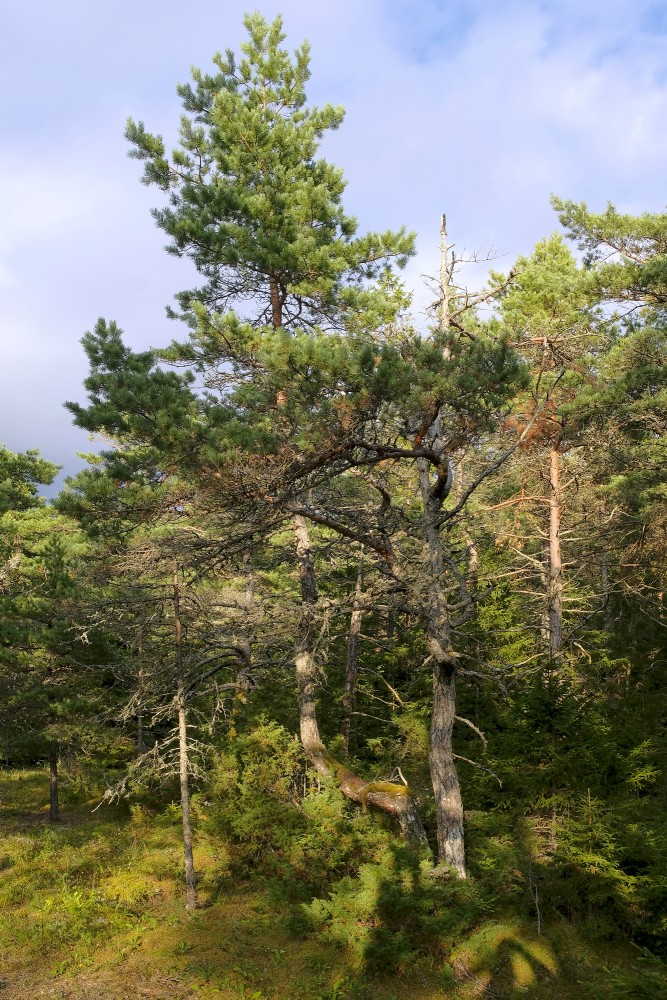Forest
A forest is a large area dominated by trees. Hundreds of more precise definitions of forest are used throughout the world, incorporating factors such as tree density, tree height, land use, legal standing and ecological function. According to the widely used Food and Agriculture Organization definition, forests covered 4 billion hectares (9.9×109 acres) (15 million square miles) or approximately 30 percent of the world's land area in 2006.
Forests are the dominant terrestrial ecosystem of Earth, and are distributed across the globe. Forests account for 75% of the gross primary productivity of the Earth's biosphere, and contain 80% of the Earth's plant biomass. Net primary production is estimated at 21.9 gigatonnes carbon per year for tropical forests, 8.1 for temperate forests, and 2.6 for boreal forests.
Forests at different latitudes and elevations form distinctly different ecozones: boreal forests near the poles, tropical forests near the equator and temperate forests at mid-latitudes. Higher elevation areas tend to support forests similar to those at higher latitudes, and amount of precipitation also affects forest composition.
Human society and forests influence each other in both positive and negative ways. Forests provide ecosystem services to humans and serve as tourist attractions. Forests can also affect people's health. Human activities, including harvesting forest resources, can negatively affect forest ecosystems.
Definition
Although forest is a term of common parlance, there is no universally recognised precise definition, with more than 800 definitions of forest used around the world. Although a forest is usually defined by the presence of trees, under many definitions an area completely lacking trees may still be considered a forest if it grew trees in the past, will grow trees in the future, or was legally designated as a forest regardless of vegetation type.
There are three broad categories of forest definitions in use: administrative, land use, and land cover. Administrative definitions are based primarily upon the legal designations of land, and commonly bear little relationship to the vegetation growing on the land: land that is legally designated as a forest is defined as a forest even if no trees are growing on it. Land use definitions are based upon the primary purpose that the land serves. For example, a forest may be defined as any land that is used primarily for production of timber. Under such a land use definition, cleared roads or infrastructure within an area used for forestry, or areas within the region that have been cleared by harvesting, disease or fire are still considered forests even if they contain no trees. Land cover definitions define forests based upon the type and density of vegetation growing on the land. Such definitions typically define a forest as an area growing trees above some threshold. These thresholds are typically the number of trees per area (density), the area of ground under the tree canopy (canopy cover) or the section of land that is occupied by the cross-section of tree trunks (basal area). Under such land cover definitions, and area of land only be defined as forest if it is growing trees. Areas that fail to meet the land cover definition may be still included under while immature trees are establishing if they are expected to meet the definition at maturity.
Under land use definitions, there is considerable variation on where the cutoff points are between a forest, woodland, and savanna. Under some definitions, forests require very high levels of tree canopy cover, from 60% to 100%, excluding savannas and woodlands in which trees have a lower canopy cover. Other definitions consider savannas to be a type of forest, and include all areas with tree canopies over 10%.
Some areas covered in trees are legally defined as agricultural areas, e.g. Norway spruce plantations in Austrian forest law when the trees are being grown as Christmas trees and below a certain height.
Etymology
The word forest comes from Middle English, from Old French forest (also forès) "forest, vast expanse covered by trees"; first introduced in English as the word for wild land set aside for hunting without the necessity in definition for the existence of trees. Possibly a borrowing (probably via Frankish or Old High German) of the Medieval Latin word foresta "open wood", foresta was first used by Carolingian scribes in the Capitularies of Charlemagne to refer specifically to the king's royal hunting grounds. The term was not endemic to Romance languages (e.g. native words for "forest" in the Romance languages evolved out of the Latin word silva "forest, wood" (English sylvan); cf. Italian, Spanish, Portuguese selva; Romanian silvă; Old French selve); and cognates in Romance languages, such as Italian foresta, Spanish and Portuguese floresta, etc. are all ultimately borrowings of the French word.
The exact origin of Medieval Latin foresta is obscure. Some authorities claim the word derives from the Late Latin phrase forestam silvam, meaning "the outer wood"; others claim the term is a latinisation of the Frankish word *forhist "forest, wooded country", assimilated to forestam silvam (a common practice among Frankish scribes). Frankish *forhist is attested by Old High German forst "forest", Middle Low German vorst "forest", Old English fyrhþ "forest, woodland, game preserve, hunting ground" (English frith), and Old Norse fýri "coniferous forest", all of which derive from Proto-Germanic *furhísa-, *furhíþija- "a fir-wood, coniferous forest", from Proto-Indo-European *perkwu- "a coniferous or mountain forest, wooded height".
Uses of the word "forest" in English to denote any uninhabited area of non-enclosure are now considered archaic. The word was introduced by the Norman rulers of England as a legal term (appearing in Latin texts like the Magna Carta) denoting an uncultivated area legally set aside for hunting by feudal nobility (see Royal Forest).
These hunting forests were not necessarily wooded much, if at all. However, as hunting forests did often include considerable areas of woodland, the word "forest" eventually came to mean wooded land more generally. By the start of the 14th century, the word appeared in English texts, indicating all three senses: the most common one, the legal term and the archaic usage. Other terms used to mean "an area with a high density of trees" are wood, woodland, wold, weald, holt, frith and firth. Unlike forest, these are all derived from Old English and were not borrowed from another language. Some classifications now reserve the term woodland for an area with more open space between trees and distinguish among woodlands, open forests, and closed forests based on crown cover.
Evolution
The first known forests on Earth arose in the Late Devonian (approximately 380 million years ago), with the evolution of Archaeopteris. Archaeopteris was a plant that was both tree-like and fern-like, growing to 10 metres (33 ft) in height. Archaeopteris quickly spread throughout the world, from the equator to subpolar latitudes. Archaeopteris formed the first forest by being the first known species to cast shade due to its fronds and forming soil from its roots. Archaeopteris was deciduous, dropping its fronds onto the forest floor. The shade, soil, and forest duff from the dropped fronds created the first forest. The shed organic matter altered the freshwater environment, slowing it down and providing food. This promoted freshwater fish.
Ecology
Forests account for 75% of the gross primary productivity of the Earth's biosphere, and contain 80% of the Earth's plant biomass. Forest ecosystems can be found in all regions capable of sustaining tree growth, at altitudes up to the tree line, except where natural fire frequency or other disturbance is too high, or where the environment has been altered by human activity.
The latitudes 10° north and south of the equator are mostly covered in tropical rainforest, and the latitudes between 53°N and 67°N have boreal forest. As a general rule, forests dominated by angiosperms (broadleaf forests) are more species-rich than those dominated by gymnosperms (conifer, montane, or needleleaf forests), although exceptions exist.
Forests sometimes contain many tree species within a small area (as in tropical rain and temperate deciduous forests), or relatively few species over large areas (e.g., taiga and arid montane coniferous forests). Forests are often home to many animal and plant species, and biomass per unit area is high compared to other vegetation communities. Much of this biomass occurs below ground in the root systems and as partially decomposed plant detritus. The woody component of a forest contains lignin, which is relatively slow to decompose compared with other organic materials such as cellulose or carbohydrate.
Components
A forest consists of many components that can be broadly divided into two categories that are biotic (living) and abiotic (non-living) components. The living parts include trees, shrubs, vines, grasses and other herbaceous (non-woody) plants, mosses, algae, fungi, insects, mammals, birds, reptiles, amphibians, and microorganisms living on the plants and animals and in the soil.
Layers
A forest is made up of many layers. Starting from the ground level and moving up, the main layers of all forest types are the forest floor, the understory and the canopy. The emergent layer exists in tropical rainforests. Each layer has a different set of plants and animals depending upon the availability of sunlight, moisture and food.
- Forest floor contains decomposing leaves, animal droppings, and dead trees. Decay on the forest floor forms new soil and provides nutrients to the plants. The forest floor supports ferns, grasses, mushroom and tree seedlings.
- Understory is made up of bushes, shrubs, and young trees that are adapted to living in the shades of the canopy.
- Canopy is formed by the mass of intertwined branches, twigs and leaves of the mature trees. The crowns of the dominant trees receive most of the sunlight. This is the most productive part of the trees where maximum food is produced. The canopy forms a shady, protective "umbrella" over the rest of the forest.
- Emergent layer exists in the tropical rain forest and is composed of a few scattered trees that tower over the canopy.
Types
Forests can be classified in different ways and to different degrees of specificity. One such way is in terms of the biome in which they exist, combined with leaf longevity of the dominant species (whether they are evergreen or deciduous). Another distinction is whether the forests are composed predominantly of broadleaf trees, coniferous (needle-leaved) trees, or mixed.
- Boreal forests occupy the subarctic zone and are generally evergreen and coniferous.
- Temperate zones support both broadleaf deciduous forests (e.g., temperate deciduous forest) and evergreen coniferous forests (e.g., temperate coniferous forests and temperate rainforests). Warm temperate zones support broadleaf evergreen forests, including laurel forests.
- Tropical and subtropical forests include tropical and subtropical moist forests, tropical and subtropical dry forests, and tropical and subtropical coniferous forests.
- Physiognomy classifies forests based on their overall physical structure or developmental stage (e.g. old growth vs. second growth).
- Forests can also be classified more specifically based on the climate and the dominant tree species present, resulting in numerous different forest types (e.g., Ponderosa pine/Douglas-fir forest).
The number of trees in the world, according to a 2015 estimate, is 3 trillion, of which 1.4 trillion are in the tropics or sub-tropics, 0.6 trillion in the temperate zones, and 0.7 trillion in the coniferous boreal forests. The estimate is about eight times higher than previous estimates, and is based on tree densities measured on over 400,000 plots. It remains subject to a wide margin of error, not least because the samples are mainly from Europe and North America.
Forests can also be classified according to the amount of human alteration. Old-growth forest contains mainly natural patterns of biodiversity in established seral patterns, and they contain mainly species native to the region and habitat. In contrast, secondary forest is regrowing forest following timber harvest and may contain species originally from other regions or habitats.
Different global forest classification systems have been proposed, but none has gained universal acceptance. UNEP-WCMC's forest category classification system is a simplification of other more complex systems (e.g. UNESCO's forest and woodland 'subformations'). This system divides the world's forests into 26 major types, which reflect climatic zones as well as the principal types of trees. These 26 major types can be reclassified into 6 broader categories: temperate needleleaf; temperate broadleaf and mixed; tropical moist; tropical dry; sparse trees and parkland; and forest plantations. Each category is described as a separate section below.
Temperate needleleaf
Temperate needleleaf forests mostly occupy the higher latitude regions of the Northern Hemisphere, as well as high altitude zones and some warm temperate areas, especially on nutrient-poor or otherwise unfavourable soils. These forests are composed entirely, or nearly so, of coniferous species (Coniferophyta). In the Northern Hemisphere pines Pinus, spruces Picea, larches Larix, firs Abies, Douglas firs Pseudotsuga and hemlocks Tsuga, make up the canopy, but other taxa are also important. In the Southern Hemisphere, most coniferous trees (members of the Araucariaceae and Podocarpaceae) occur in mixtures with broadleaf species, and are classed as broadleaf and mixed forests.
Temperate broadleaf and mixed
Temperate broadleaf and mixed forests include a substantial component of trees in the Anthophyta. They are generally characteristic of the warmer temperate latitudes, but extend to cool temperate ones, particularly in the southern hemisphere. They include such forest types as the mixed deciduous forests of the United States and their counterparts in China and Japan, the broadleaf evergreen rainforests of Japan, Chile and Tasmania, the sclerophyllous forests of Australia, central Chile, the Mediterranean and California, and the southern beech Nothofagus forests of Chile and New Zealand.
Tropical moist
There are many different types of tropical moist forests, with lowland evergreen broad leaf tropical rainforests, for example várzea and igapó forests and the terra firma forests of the Amazon Basin; the peat swamp forests, dipterocarp forests of Southeast Asia; and the high forests of the Congo Basin. Seasonal tropical forests, perhaps the best description for the colloquial term "jungle", typically range from the rainforest zone 10 degrees north or south of the equator, to the Tropic of Cancer and Tropic of Capricorn. Forests located on mountains are also included in this category, divided largely into upper and lower montane formations on the basis of the variation of physiognomy corresponding to changes in altitude.
Tropical dry
Tropical dry forests are characteristic of areas in the tropics affected by seasonal drought. The seasonality of rainfall is usually reflected in the deciduousness of the forest canopy, with most trees being leafless for several months of the year. However, under some conditions, e.g. less fertile soils or less predictable drought regimes, the proportion of evergreen species increases and the forests are characterised as "sclerophyllous". Thorn forest, a dense forest of low stature with a high frequency of thorny or spiny species, is found where drought is prolonged, and especially where grazing animals are plentiful. On very poor soils, and especially where fire or herbivory are recurrent phenomena, savannas develop.
Sparse trees and parkland
Sparse trees and savanna are forests with lower canopy cover of trees. They occur principally in areas of transition from forested to non-forested landscapes. The two major zones in which these ecosystems occur are in the boreal region and in the seasonally dry tropics. At high latitudes, north of the main zone of boreal forest, growing conditions are not adequate to maintain a continuous closed forest cover, so tree cover is both sparse and discontinuous. This vegetation is variously called open taiga, open lichen woodland, and forest tundra. A savanna is a mixed woodland grassland ecosystem characterized by the trees being sufficiently widely spaced so that the canopy does not close. The open canopy allows sufficient light to reach the ground to support an unbroken herbaceous layer consisting primarily of grasses. Savannas maintain an open canopy despite a high tree density.
Forest plantations
Forest plantations are generally intended for the production of timber and pulpwood. Commonly mono-specific and/or composed of introduced tree species, these ecosystems are not generally important as habitat for native biodiversity. However, they can be managed in ways that enhance their biodiversity protection functions and they can provide ecosystem services such as maintaining nutrient capital, protecting watersheds and soil structure, and storing carbon.
en.wikipedia.org
